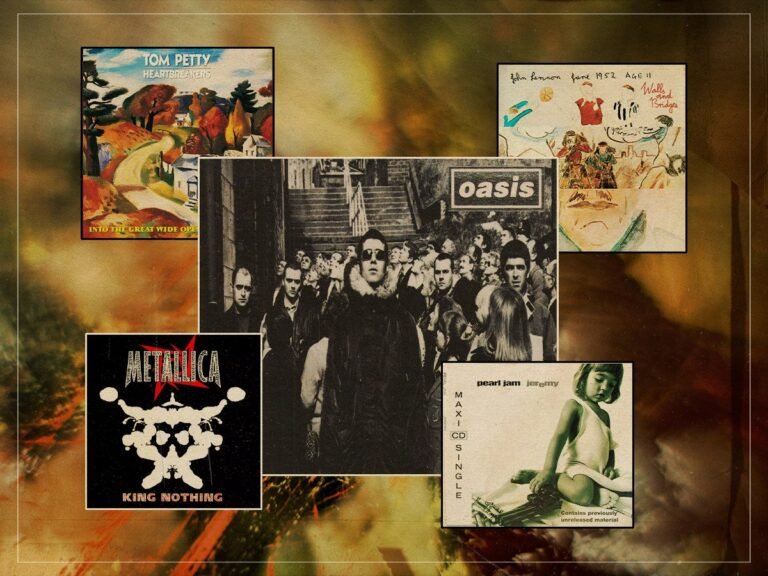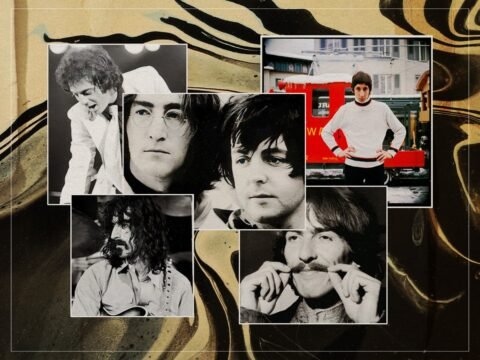‘Footsteps’ – Pearl Jam

Living in Seattle always meant playing with different bands every other week. Band guidelines and loyalty to a certain group never really applied to the Pacific Northwest, and every other week, you could find people that you would presume to be legends in their own right joining someone else’s band for a handful of tunes. It was all part of the Seattle community mindset, but when Pearl Jam were getting birthed, Stone Gossard had a few riffs hanging around from his post-Mother Love Bone days.
There had already been the makings of Pearl Jam songs in Gossard’s old outfit, like the song ‘Dollar Short’, but the beginnings of the song ‘Footsteps’ actually start with the song ‘Times of Trouble’. Using the exact same riff, the song became one of the most beloved deep cuts while Chris Cornell was working with Gossard on Temple of the Dog before it fell into the hands of a San Diego surfer named Eddie Vedder.
Although the riff is part of the trilogy of songs that got Vedder into the band, the accompanying story he put together out of the three songs would be chopped up, with ‘Footsteps’ being relegated to the B-side of the ‘Jeremy’ single. Cornell’s lyrics about moving on from trauma may have hit closer to home, but as Vedder sings about a man on death row awaiting his execution, you can hear him slowly start to lose his mind as Gossard’s riff plays out his final moments.
‘Crazy’ – Aerosmith

There are usually two schools of thought when it comes to Aerosmith’s work in the 1990s. Either this was a bold new reinvention for them that brought about their third or fourth wind, depending on how you count it, or this was the moment where they started to sell out and became the kind of basic rock and roll band that could be replaced with any other dinosaur rock act. On Get A Grip, though, they had a solid helping of tunes to back up their transition into the 1990s, but you’d think they’d have the common sense not to put the identical songs right next to each other.
Most Aerosmith albums live off the success of the ballads, but outside of the song ‘Cryin’, ‘Crazy’ feels like a blatant retread of what we had heard a few songs ago. Both of them are in the key of A major, both of them are about a turbulent relationship, and both of them are in waltz time, but since they have different lyrics and Steven Tyler shoots his voice into the stratosphere on ‘Crazy’, I guess they may as well be two different songs.
Hearing Tyler recycle lyrics from ‘Walk This Way’ for their later song ‘Legendary Child’ could have easily been an honourable mention on this kind of list, but the only reason why this earns a spot here is the hilarity in the band thinking they could get away with this kind of stunt. If you had to pick one, the kickass horn break in ‘Cryin’ does rock a little bit harder, but getting this kind of mileage out of two identical songs is never bad for business.
‘The Chain’ – Fleetwood Mac

Fleetwood Mac easily had some of the worst luck that ever befell a rock and roll outfit. It was already bad enough having to move on from the turbulent years with Peter Green in the group, but now with Bob Welch leaving the band in the mid-1970s, they were faced with changing a frontman yet again. But even with Lindsey Buckingham and Stevie Nicks adding their own magic to their songs, Rumours proved that the only way for someone to get a song done right is if they had everyone working together.
‘Go Your Own Way’ and ‘Dreams’ may have been perfect creations on their own, but the makings of the Christine McVie song ‘Keep Me There’ never felt fully fleshed out. After going through his song library, Buckingham emerged with the riff from the song ‘Lola (My Love)’ from the Buckingham Nicks album. ‘Frozen Love’ was the tune that impressed them, but starting things off with this new fingerpicked set the song into motion.
After stringing together different ideas and putting John McVie’s iconic bassline in the middle of the tune, the jam eventually morphed into ‘The Chain’, which really stands as the mission statement of Rumours. Everyone wanted nothing to do with each other and came close to breaking themselves apart more than a few times, but as long as they had the music to carry them through, they could make anything work.
‘D’You Know What I Mean’ – Oasis

Noel Gallagher has made absolutely no apologies for being a song thief over the years. The whole point of good pop music is drawing inspiration from what came before, and even if ‘Cigarettes and Alcohol’ sounds exactly like T Rex’s ‘Bang A Gong’, ‘The Chief’ always managed to make it work in a completely different context. So since he believed that Oasis were the greatest band in the world, it was only a matter of time before he began using his own riffs over again.
There had already been some psychedelic touches on Definitely Maybe and a few odes to The Beatles on What’s the Story Morning Glory, but the opening of Be Here Now feels like the bizarro world version of ‘Wonderwall’, complete with Noel using the exact same chords for most of ‘D’you Know What I Mean’. And while it does go on a bit too long and shows both of the Gallaghers at the height of their hubris, this is one of the few instances where their musical “borrowing” works a lot better.
After all, Owen Morris talked about having to strip away many of Noel’s ideas for the original version of ‘Wonderwall’, so maybe this is what the song was supposed to sound like once the producer let him do whatever he wanted. Nothing was ever going to knock them off their pedestal as rock’s new legends, but given where the band went after this album, ‘D’You Know What I Mean’ is both a rehash of their old stuff and a farewell to their glory days.
‘All You Need is Love’ – The Beatles

Some of the greatest artists always work well under pressure. Even though it might seem impossible for any songwriter to string together a classic whenever they get into the studio, it’s much easier for them to work if they have a deadline to work off of or are told that they need to make a classic within an hour. But even with John Lennon’s back up against the wall trying to write a Beatles song for the Our World broadcast, ‘All You Need is Love’ has a bit more Easter eggs than many people thought.
The whole broadcast was supposed to be this grand celebration of love, and while working on a deadline, Lennon came up with one of the most complex love songs he ever wrote, talking about how anything is possible with that fire in your heart. But as the song starts trailing off and the orchestra starts cutting loose on their instruments, Paul McCartney decided to have some fun on the final broadcast, eventually shoehorning in a sing-along chorus of ‘She Loves You’ in the final seconds of the song.
It was easily a throwaway line for the early Beatles fans, but compared to where they had come since 1964, ‘All You Need Is Love’ feels like it exists in a completely different world. Things were still black and white when the Fab Four started, and by the time the broadcast ended, the Summer of Love was officially underway, and millions of kids were finding out that love was the answer to all of their problems.
‘King Nothing’ – Metallica

Metallica already knew they were playing with fire when they went into the studio to make The Black Album. Bob Rock was responsible for creating some of the most electrifying rock and roll albums ever made, and if he had worked the same magic he had done for Bon Jovi on this album, metal would finally be given to the masses in the right way. So when they finally finished it, the thrash icons had one goal in mind: don’t make Black Album part 2. Then again, you wouldn’t know that from their first single.
Whereas most people were paying attention to the band’s look and convincing themselves that their favourite metal band had sold out, ‘King Nothing’ isn’t straying that far away from the formula. If anything, this is almost a little too on the nose. From the way the riff is constructed to how the song is structured by repeating the same riff over and over again, this is almost an exact carbon copy of ‘Enter Sandman’, very nearly using the same scale shape for the central riff.
It appears that even James Hetfield realised that the songs sounded a bit too similar, since he sings the line ‘off to never never land’ at the end of the tune. This could justifiably be considered a callback in that respect, but considering what else is on Load, fans were right not to expect anything too heavy. Because if anyone was expecting tunes like ‘Don’t Tread On Me’, they were going to be very disappointed when they heard tracks like ‘Mama Said’ and ‘Bleeding Me’ on their first listen.
‘All The Wrong Reasons’ – Tom Petty

Tom Petty was already on a high after entering the 1990s. Full Moon Fever had become one of the highlights of his career, and even if it left a couple of Heartbreakers feeling jaded that they weren’t on it, Jeff Lynne was back on board to work the same magic for the rest of the group when Into the Great Wide Open. This was heartland rock with a bit more sheen behind it, but some of Petty and Lynne’s sensibilities rubbed off too well midway through the record.
Although most of the band sounds fantastic on tracks like ‘Learning to Fly’, does anyone else get a sense of deja vu when listening to ‘All the Wrong Reasons’? Let’s take a look here. A song about a lonely girl who ends up going against her parents’ wishes and makes a new life for herself with a wild and restless boy? Yep, even with the same key, this is unintentionally part two of ‘Free Fallin’. But at the risk of pissing off hardcore Petty fans, this version of the tune might actually be better.
The one thing that every great song needs is some kind of bittersweet feeling to it, and when listening to Petty sing those ‘oh-ohs’ in the chorus, it could either be the sound of protagonist having the time of their lives away from home or the concerned mothers shaking their heads wondering where the hell their children will end up at night. The song might not have the happiest of endings, but in the heartland, it’s better to be true to life than rewrite the stories we all already know.
‘Steel and Glass’ – John Lennon

John Lennon never suffered fools gladly when he got to the studio. He may not have been the most technically proficient guitarist in the world, but if he knew what he didn’t like, it would be noted, be it with the session players hired for the gig or the sound of his voice in his headphones. But after ripping his writing partner a new one on ‘How Do You Sleep’, Lennon seemed to be using some of his riffs for different reasons later down the line.
Most of his problems with Paul McCartney were water under the bridge by the mid-1970s, but when Walls and Bridges came out, ‘Steel and Glass’ was the first time he took aim at his former manager, Allen Klein. Since he was the guy who should have been responsible for The Beatles’ demise, Lennon tosses in a few sly jabs at his old business partner, only this time using the ‘How Do You Sleep’ riff to attack his manager.
Although one shouldn’t condone a riff that was designed to hurt someone, it does feel a little invigorating for Lennon to use that idea again, given the fact that Klein was there when he was writing ‘How Do You Sleep’ and had a hand in throwing in a couple of jabs at Macca as the tune was being written. So by using it in this context, Lennon is throwing shots at Klein with the exact same weapon Klein used to shoot down McCartney.
‘Seven Days’ – Sting

Any songwriter usually knows when they have a hit on their hands. Even if it only took them a couple of minutes to throw some chords together, there’s a certain magic that comes from someone hitting on the perfect melody and capturing it on tape for the first time. If they go on to record it, though, they’re going to make sure it’s done right, and Sting made sure that everyone knew that he would be remembered for at least one major hook both with the Police and on his own.
Before their turn towards pop music, though, Sting had ‘Every Little Thing She Does Is Magic’ in the can and was hesitant to give it to the rest of the group. He knew he could make a fortune if he had the right format, but when their label head, Miles Copeland, insisted that they cut the record immediately, Sting knew he wasn’t done. He needed more time to work on it, which meant having some fun on his later projects.
The line about him spending a thousand rainy days since they first met was already given two hooks on the original, but then ‘O My God’ comes along one album later with the same lyrics with a different melody. And what’s that I hear at the end of ‘Seven Days’? Why it’s the exact same hook but in a different context, this time slowed down a little bit more. It would be ridiculous for someone to use a hook that many times, but considering this is the same person who got two hits out of ‘Don’t Stand So Close To Me’ and Dire Straits’ ‘Money for Nothing’, it’s not shocking to see him have a hit all over again.
‘Shine On You Crazy Diamond’ – Pink Floyd

How do you properly move on after losing one of your best friends? There is always a lot of shared history between bandmates, and when one of them suddenly disappears from your life, there’s no way to properly fill that hole with someone else. And while David Gilmour did an admirable job taking over for Syd Barrett in Pink Floyd, there was always something at the back of everyone’s mind once they finally got famous.
Since someone very special wasn’t there to share in their success after Dark Side of the Moon, ‘Shine On You Crazy Diamond’ was sculpted as one long tribute to Barrett’s memory. Although most people would make short and sweet memorials to their best friends, both parts of this tune feel like condensing the entire experience of friendship into a few minutes, from the anxiety of knowing that they’re gone to the comfort of remembering all of the great times that you had with them.
And to put the final cherry on top of the album Wish You Were Here, Richard Wright throwing in the melody of ‘See Emily Play’ at the very end of the tune is one of the most touching moments in Pink Floyd’s career. There are bound to be arguments until the end of time regarding which Floyd album has the best songs or the best production, but regardless of which album is best in your mind, not many of them have something as brilliant as ‘Shine On’ in their track listing.





